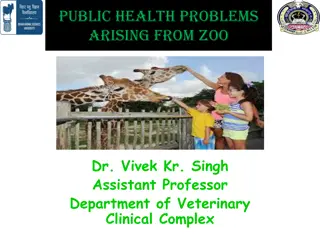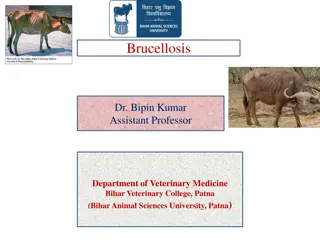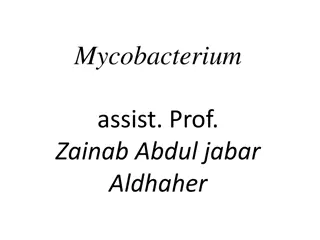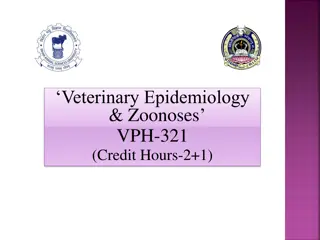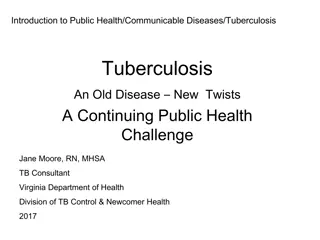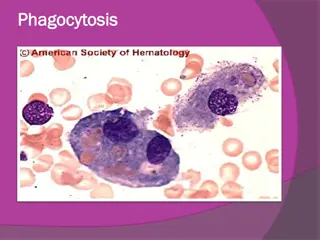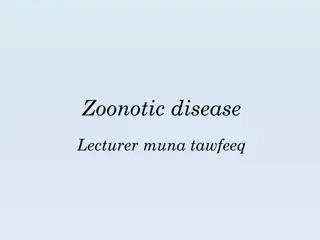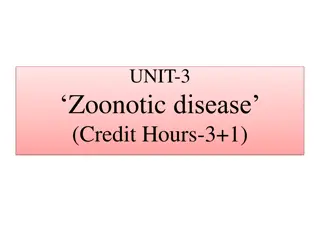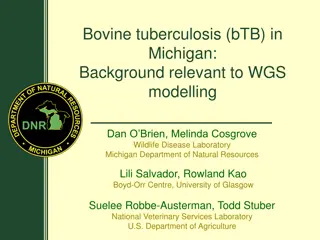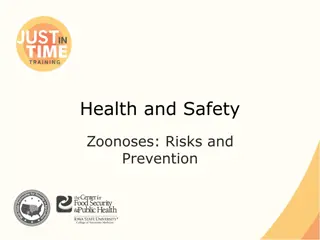Bovine Tuberculosis: A Zoonotic Disease Impacting Humans and Animals
Bovine tuberculosis is a chronic bacterial disease affecting cattle and other mammals, with potential transmission to humans. Endemic in developing countries, it poses public health risks. Modes of transmission, clinical symptoms, diagnosis, and control measures are discussed, highlighting the importance of eradication programs and prevention strategies.
Download Presentation

Please find below an Image/Link to download the presentation.
The content on the website is provided AS IS for your information and personal use only. It may not be sold, licensed, or shared on other websites without obtaining consent from the author.If you encounter any issues during the download, it is possible that the publisher has removed the file from their server.
You are allowed to download the files provided on this website for personal or commercial use, subject to the condition that they are used lawfully. All files are the property of their respective owners.
The content on the website is provided AS IS for your information and personal use only. It may not be sold, licensed, or shared on other websites without obtaining consent from the author.
E N D
Presentation Transcript
Tuberculosis Dr. Bipin Kumar Assistant Professor Department of Veterinary Medicine Bihar Veterinary College, Patna (Bihar Animal Sciences University, Patna)
Bovine tuberculosis Definition Etiology Species Affected by M. Bovis Occurrence/Geographical distribution Mode of transmission Survivability of M. bovis Population at risk Incubation Period Clinical symptoms Postmortem lesions Morbidity & mortality Laboratory diagnosis Sample Collection Differential diagnosis Treatment in humans Prophylaxis/ Control Vaccine Outbreak reports Public health significance
Bovine tuberculosis is a chronic bacterial disease of cattle that occasionally affects other species of mammals. This disease is a significant zoonosis that can spread to humans, typically by the inhalation of aerosols or the ingestion of unpasteurized milk. Mycobacterium Gram positive Acid-fast bacterium (AFB) Family Mycobacteriaceae. Mycobacterium tuberculosis- human Mycobacterium bovis- zoonoticTB Mycobacterium capare- zoonoticTB (rarely) Mycobacterium canis- dog
Endemic in developing and under-developed cattle rearing countries- Africa, parts of Asia and some middle eastern countries. Ongoing Eradication Programs in- UK, USA, NZ, Japan, Mexico,. TB free countries- Australia, Iceland, Denmark, Sweden, Norway, Finland, Austria, Switzerland, Luxembourg, Latvia, Slovakia, Lithuania, Estonia, the Czech Republic, Canada, Singapore, Jamaica, Barbados and Israel.
Transmission ANIMAL-ANIMAL Horizontal transmission- inhalation of aerosols(cats, badgers), by ingestion(calves, pigs, cats, ferrets), or through breaks in the skin (cats, badgers). Shedding of bacteria in- faces, milk, discharging lesions, saliva, vaginal fluids, semen and urine. (later stages of disease) Close, prolonged contact of healthy animals with infected animal Intensive livestock farming; Extensive livestock farming (vaccination centers, AI Centers, Dipping tanks, Auction markets, transportation, ponds, wells and streams, in tropical areas gathering under shady areas during hot part of the day, salt supplementing points) Vertical transmission-Congenital infections (rare in developed countries with an effective eradication program)
Animal to human PulmonaryTB- more in rural dwellers due to inhalation of infected dust GastrointestinalTB- more in urban dwellers due to ingestion of unpasteurized milk and dairy products HIV people Human to animal -Rare Genito-urinaryTB urination in cowsheds/ pasture animal craving salt would prefer grazing there Human to human Rare Less efficient than M. Tuberculosis HIV infected humans are highly susceptible
Survivality of mycobacterium Several months in Cold, dark, moist conditions. 12-24C 18-332 days Susceptible to sunlight
Population at risk Occupational Risk Farmers, Abattoir workers,Veterinarians, Laboratory technicians, Animal caretakers in zoos, Workers in animal reservations and national parks, Close association with people living with animals or working with them. Susceptible age group- Infants, Pregnant women, Old. Consumption related risk factors - Nutritionally deficient people Consumers of unpasteurized milk, Raw meat or Undercooked meat. Medical conditions HIV positive humans Diabetics Previously incorrectly treated TB patients
Incubation Period Takes months to develop Dormant for years and reactivating during period of stress or old age 2-5 weeks Kittens-experimentally IP is 3 weeks.
Clinical signs Humans; A bad cough that lasts 3 weeks or longer. Pain in the chest. Coughing up blood or phlegm from deep inside the lungs. Weakness or feeling very tired. Losing weight without trying. Having no appetite. Chills and fever. Sweating at night or when sleeping. In Animals: Early on it remains asymptomatic -Late stages progressive emaciation, a low grade fluctuating fever, weakness and inappetence.
Animals with pulmonary involvement a moist cough that is worse in the morning, during cold weather or exercise, dyspnea or tachypnea. In the terminal stages, animals may become extremely emaciated acute respiratory distress, retropharyngeal or other lymph nodes enlarge and may rupture and drain. Greatly enlarged lymph nodes can also obstruct blood vessels, airways, or the digestive tract. If the digestive tract is involved, intermittent diarrhea and constipation may be seen
Granulomas (tubercles) where bacteria have localized. Usually yellowish,either caseous, caseo-calcareous or calcified Often encapsulated, found in the lymph nodes, particularly those of the head and thorax. common in the lung, spleen, liver and the surfaces of body cavities.
Morbidity and mortality Infective dose: Cattle: 1 CFU (colony forming units)=6-10 viable bacilli; Human respiratory route: 10 s to 100 s bacteria; Millions by gastrointestinal route 100% mortality if not treated.
Daignosis Cattle: Tuberculin skin test (screening test) Microscopic examination of AFB Ziehl/Neelson stain Flourescent acid-fast stain Isolation on selective culture media (8 weeks) PCR Biological safety cabinet should be used Wildlife: Lymphocyte proliferation assay/gamma-interferon assays / ELISA.
Sample collection Samples from Live animal: Sputum and other body fluids Blood samples Samples at necropsy: Abnormal lymph nodes ,Lungs ,Liver,Spleen
Differential diagnosis Contagious bovine pleuropneumonia Pasteurella Corynebacterium pyogenes pneumonia Aspiration pneumonia Traumatic pericarditis Caseous lymphadenitis Liver fluke infestation
Treatment Isoniazid Rifampicin Ethambutol Pyrazinamide Streptomycin 6months MDRTB 2 years Rx 3lakh/year expense
Prophylexis/Control Why control??? Risk of infection to human Loss in productivity Animal market restrictions set by countries with advanced eradication programs Threat to endangered wild animal species Failure of control programs in developing countries??? Cannot shoulder the cost of eradication program and compensate for culled animals. Limited access to education Poor information networks Lack of disease surveillance
MandatoryTest-and- slaughter strategy or test- and-segregation. Periodic re-testing of infected herd Quarantine Trace back reactor and those that came in contact with them Strong Disinfection with 5% phenol, iodine solutions, glutarldehyde and formadehyde long contact time Rodent control Barrier the area to prevent wildlife interaction with domestic animals. Pasteurization of milk Awareness about the deleterious effects of unpasteurized milk consumption. Proper cooking of meat. Restricted animal movement. Involvement of ministry of health in coalition with agriculture industry for combined efforts to reduce bovineTB
Vaccine HumanTB Bacillus CalamiteGuerin (BCG) Attenuated strain of wild type of M. bovis isolate from cattle Bovine TB BCG vaccination in animals less effective





